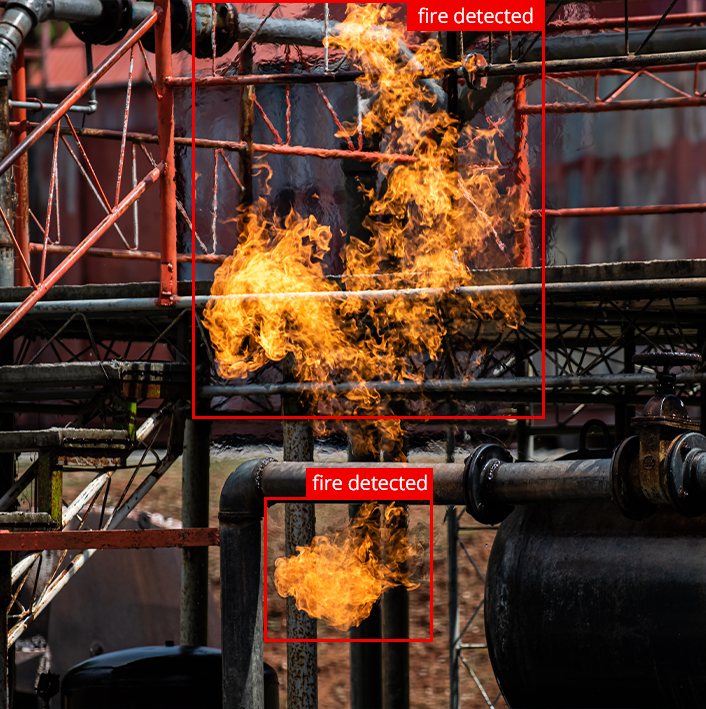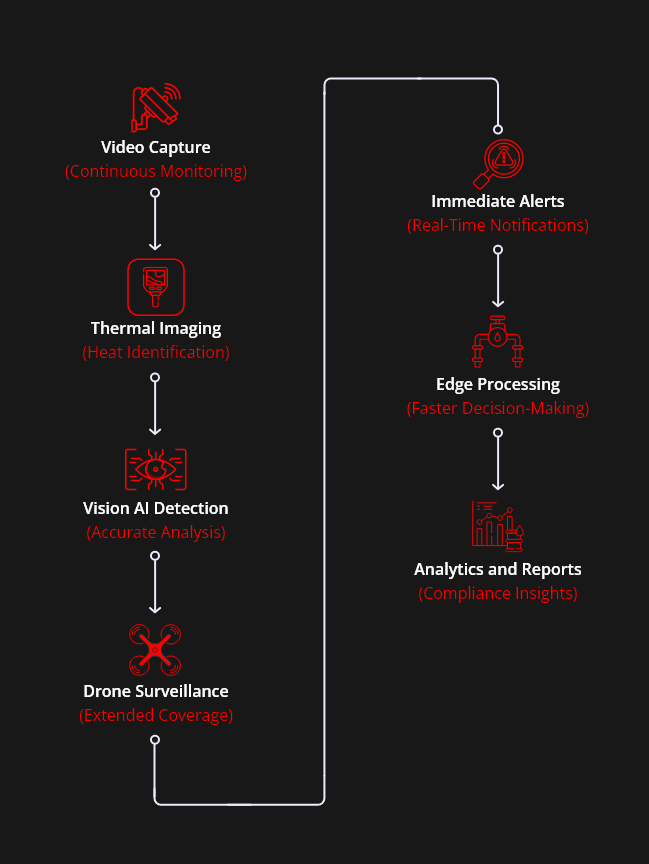Fire and Smoke Detection
Computer Vision-Based Fire Detection System for Oil & Gas Safety
Fire is an unfortunate phenomenon that causes terrible damage to property and the environment, threatening human safety and lives, especially when out of control. In oil and gas settings, fires often remain undetected by conventional smoke sensors until they are severe. Computer Vision-based fire detection systems use a multifaceted approach, employing fixed surveillance cameras for continuous monitoring and drone-based systems to provide aerial views of critical infrastructure and access remote or hazardous areas. This enables early detection of smoke or fire initiation and effectively minimizes risks.

Fire and Smoke Detection Challenges in Complex Industrial Environments
In oil and gas facilities, fire and smoke detection require specialized approaches due to the complexity of environments, vast monitoring areas, and the presence of hazardous materials.
- Faulty Equipment and Electrical Malfunctions: Fires frequently start from faulty electric or gas equipment, creating significant hazards in industrial settings.
- Delayed Detection in Large Areas: Traditional smoke detectors rely on proximity, which delays the detection of fires across expansive or remote facilities.
- Environmental and Financial Losses: Fires in oil and gas sites pollute the environment and lead to extensive financial damage due to destroyed assets and halted operations.
- High False Alarm Rates: Heat, dust, and gas often trigger false alarms in traditional systems, leading to unnecessary disruptions and lowered trust.
- Global Warming and Climate Risks: Rising temperatures and severe weather intensify fire risks, especially in areas with flammable materials near industrial zones.
Deep Learning Solution for Fire and Smoke Detection in Oil and Gas Facilities
A process flow integrates Computer Vision with real-time analytics to address oil and gas facility’s fire detection challenges. This ensures timely and precise detection to minimize risks and damage.
- Video Surveillance: High-definition cameras monitor critical zones, capturing detailed visual data in industrial environments.
- Thermal Imaging: Thermal cameras identify abnormal heat patterns, detecting fire risks before visible smoke appears.
- AI-Powered Detection: Deep Learning algorithms like CNN and YOLO analyze real-time video feeds to identify smoke and fire while reducing false alarms accurately.
- Drone Monitoring: Vision AI-equipped drones provide coverage for remote or hazardous areas, ensuring comprehensive monitoring.
- Immediate Alerts: Automatic notifications enable rapid response, preventing fire escalation.
- Edge Computing: Local data processing reduces latency, ensuring quick decision-making in critical situations.
- Reporting and Analytics: Detailed reports on incidents, response times, and conditions ensure compliance and continuous improvement.


Core Capabilities of Fire and Smoke Detection with Computer Vision
Fire and smoke detection with Computer Vision provides robust solutions for early detection, real-time monitoring, and accurate alerts, ensuring comprehensive safety in high-risk environments.
- Early and Accurate Detection: Quickly identifies smoke and fire through real-time video analysis, ensuring timely alerts.
- Wide Coverage: Enables monitoring of large and remote areas, often unreachable by traditional sensors.
- Reduced False Alarms: Computer Vision algorithms differentiate between threats and environmental interferences.
- Real-Time Alerts: Provide instant notifications to safety teams, supporting faster response and risk mitigation.
- Adaptability: Performs reliably in challenging conditions, including low lighting and extreme weather.
Fire and Smoke Detection Using Vision AI for Safer Oil and Gas Operations
Developed to address the rigorous demands of oil and gas operations, the Computer Vision-based fire and smoke detection system ensures early and precise detection, reduces false alarms, and strengthens safety protocols. It effectively manages critical challenges, safeguards personnel, valuable assets, and the environment, and maintains operational efficiency.
